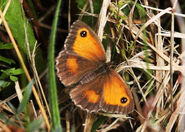
Gatekeeper - WWC Archives
The Gatekeeper (Pyronia tithonus) sometimes called the Hedge Brown is a common butterfly in the United Kingdom. It is a member of the subfamily Satyrinae in the family Nymphalidae. A similar species is the Meadow Brown; the two species can be difficult to distinguish with closed wings since underwing markings are very similar. However, the Gatekeeper tends to rest with its wings open, whereas the Meadow Brown usually rests with its wings closed. The Gatekeeper is also smaller and more orange than the Meadow Brown and has double pupils on its eyespots.
Biology[]
The larvae of Satyrinae all feed on grasses, such as Rough Meadowgrass Poa trivialis, Smooth Meadow Grass Poa pratensis, Sheep's Fescue, and are usually green or brown in colour. The pupae are a flimsy chrysalis either hanging upside down or lying in grass. The adults are often found round blackberry plants. The adult butterflies have a quite short proboscis and the flowers of the blackberry being quite shallow provide an excellent nectar source. Males have a dark patch of scent scales in the middle of the forewing for courtship purposes except in very old individuals. This dark patch is clearly visible in the male Gatekeeper. The characteristic eyespots on the forewing probably deflect bird attacks away from the butterfly's body rather than startle away predators; the Gatekeeper likes to rest with its wings open and the eyespots visible. It flies more but strays about less than the male Meadow Brown.
Two similar species of Pyronia are found in southern Europe, the Southern Gatekeeper (P. cecilia) and the Spanish Gatekeeper (P. bathsheba).
Sexual dimorphism[]
The Gatekeeper, like many Satyrinae, exhibit sexual dimorphism. The male has a dark patch on the upper side of the forewing. This is an area of scent-producing scales known as the androconia.
The favourite plants for the Gatekeeper are brambles, marjoram and ragwort. It is also called Hedge Brown. It feeds on the nectar it finds whereas the caterpillars feed on grasses. A male will set up a territory along a hedgerow and guard it to keep other butterflies out. The female scatters eggs on grass as she flies. The caterpillar is green, with a greyish-brown head and pale stripes on its flanks. It lives from August to the next June and hibernates during winter months. It flies during the summer and adults will live for about three weeks.
Profile[]
Size: Wingspan 3.4-3.8 cm
Description: Upper sides are mid-brown, and have orange-brown patches with a twin white eye-spot. The undersides are lighter with several small eye-spots. Male has a brown streak at the centre of the forewing and females are lighter in colour.
Habitat: Hedgerows, woodlands and grasslands.


